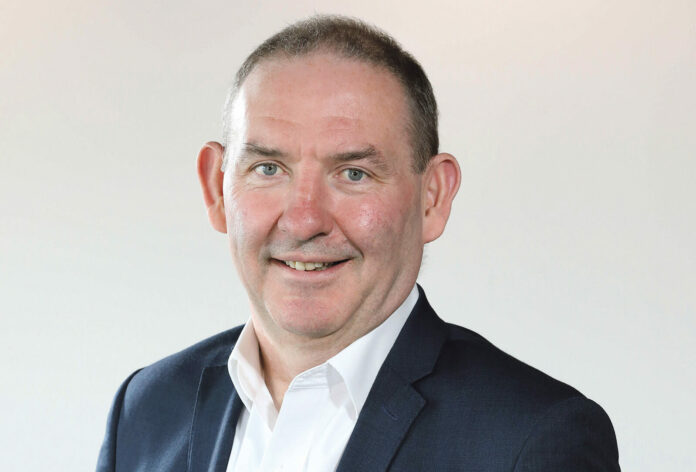In an exclusive interview with the Clare Champion, Conal Henry says he aims to get Shannon Group and the airport out in front of the challenges it will face in future
PÁDRAIG Ó Céidigh lasted less than six months before resigning in frustration as chairman of Shannon Group, while his predecessor Rose Hynes faced often scathing criticism during her time in the role.
Clearly being chairman of Shannon Group is a role that exposes one to widespread scrutiny.
While someone with Conal Henry’s background certainly can’t have been convinced to take up the role for the money, why has the Belfast man accepted the role that Mr Ó Céidigh branded “the most challenging job in Irish aviation”?
“First of all, and this sounds crass, but I really mean it, you don’t do things for money, you do things to deliver better outcomes, to effect change that benefits people.
“I’m very happy getting involved in a project like Shannon, I find the subject matter very interesting, this is the sort of thing I enjoy doing,” he said, in an interview with the Champion.
Originally from Belfast, a young Conal Henry studied law at Queens in the late 1980s and early 1990s, but the anticipated law career never began.
“What I say to people is that I did a law degree and I was going on to be a barrister, I took a year out and I’m still on it!” he laughs.
Henry went to work for Procter & Gamble and then Asda in the UK, going into finance rather than the law, before returning to Ireland to work for an up and coming airline.
“I went from working for the company that makes the soap powder to working for the supermarket that sells the soap powder.
“I came back to Ireland and worked for Ryanair, I was commercial director for Ryanair and did a lot of new route development stuff, all that sort of stuff, it was a stage when they were growing really, really quickly. One of my big responsibilities was dealing with airports.”
It was an exciting time to be with Ryanair, as it was expanding so quickly with ever more growth on its horizon.
“When I was in Ryanair it passed out Aer Lingus and people started to realise this isn’t a small low cost airline, it’s something that’s a real force in aviation and a coming force.
“By the time I left there were over 30 million passengers and now there’s over 100 million passengers. When I started there was six million.
“We did the Boeing deal, we acquired Buzz, it was just when ten new member States joined the EU so that opened up places like Poland, the Czech Republic, all these sorts of places.”
After leaving that he worked in telecoms, an industry where he has had huge success, and which introduced him to the Mid-West.
“I got involved in a large telecoms company called Energis. We were involved as a management team in turning that around and we turned it around and sold it to Cable & Wireless.
“Then I got involved in an Enet Project with Michael Tiernan, he owns Arthur’s Quay and places like that in Limerick. I started working with him on the Metropolitan Area Networks Project, we set up ENet, that was 2005/2006 time, we raised a few million in investment capital to run these networks and took it from zero revenue to €50 million when we sold it in 2017 or 2018.
“David McCourt came in as chairman of ENet and I worked with David for five years. We grew Enet significantly and won the National Broadband Plan.
“I then sold out and performed the same trick in Northern Ireland, set up a company called Fibrus and we’ve won the Northern Ireland version of the National Broadband Plan.”
There is a feeling around Clare and Limerick that Shannon does need leadership with strong local knowledge, and on a superficial level the recruitment of a chairman from Belfast who lives in Dublin seems contrary to this, but he has worked in the region for many years and knows it well.
“I spent 12 years working in Limerick and I’d be very familiar with the business scene there, I’d have been in and out of Shannon Airport quite a lot, flying over to investors in London and stuff, I’m not a stranger to the Mid-West at all.”
He says his knowledge of the region, along with his aviation experience and the experience he’s had of dealing with government through telecommunications means he has a background that will be useful for Shannon.
“People might ask how’s this guy going to help Shannon, those are the things that I’m bringing.”
Every airport in Ireland and beyond saw its traffic collapse after the pandemic struck, and there were concerns that recovery would be much harder for smaller ones like Shannon.
However it does seem to be going fairly well to date, with the key services to Heathrow and America restored and Ryanair having recommenced many routes.
“The passenger numbers this year will be heading back to where they were immediately pre Covid. The transatlantics are back, Heathrow is back, the services that the Mid-West needs are coming back,” says Henry.
Back in the glory days of the Celtic Tiger, Shannon recorded a stunning 3.6 million passengers per annum, but a long decline set in as the economy turned, which has only been partially reversed in recent years.
In 2019, just before the pandemic, the airport had 1.7 million passengers, so what can it expect over the next few years?
“If I give you a number it’ll definitely be wrong, it’ll be either bigger or smaller than that, it’ll definitely be wrong. The focus is making that number as big as we possibly can.
“It’s about making sure we have quality relationships with the airlines, with Aer Lingus and Ryanair in particular, but also with Emerald Air, the likes of the big European carriers, Lufthansa, KLM, these guys. The big US airlines, United, American, Delta, we need to make sure those guys understand the Shannon product, what Shannon can bring for their passengers, how Shannon is a proposition for those airlines that works. If we do that we’ll get as many passengers as possible to the airport. How many is that? It’s really, really hard to say, it’s a notoriously volatile industry, it’s really hard to give a number. One decision, one airline can change your year and that decision might not be a rational one sometimes.”
He says that Shannon will always have to fight hard for business, given the number of other airports that can be reached fairly easily from this region.
“Shannon is the most competed-with airport in Ireland. It has Farranfore and Cork to the south, it has Knock to the north and Dublin to the east, all of which are choices available to people in the catchment area. It’s a massively competed-with airport.
“I think we have to be realistic, the passenger numbers at Shannon, we can get them higher and will get them higher, but we have to be realistic as to what we expect the level of traffic through that airport to be, given that there are essentially four airports competing with it.”
The State’s aviation policy has been criticised in Clare for years, as Dublin grew its passenger numbers dramatically, while Shannon floundered.
In recent weeks there has been a feeling of vindication in some quarters, as Dublin struggled to cater for what it had, and Henry feels that the Government does need to reframe its policy.
“Shannon is now under the Regional Airports Programme and that’s given us a bit of firepower to attract airlines in and it’s really important that the State continues with that.
“Short of building a second airport in Dublin, the State needs to make the regional airports and particularly the biggest one, Shannon, it needs to make it a competitive proposition for passengers against Dublin.
“Dublin is at capacity even now, the runways are full up, the terminals are full up. Dublin must be the biggest city in Europe with only one airport. Dublin Airport needs a competitive force against it, and we would seek to be that, with the support of the State.”
Over the last five years there has been a lot of negativity around Shannon Group, with plenty of criticism of those involved, and he feels that went too far.
“There’s a lot of noise, they’re doing this wrong, they’re doing that wrong, but what Shannon has achieved throughout its history and what it continues to achieve is phenomenal.”
“I think we all need to remind ourselves of that a wee bit. Actually this is a great business doing great things for the Mid-West.”
With changes in technology and far greater awareness of global warming, he feels aviation is inevitably going to change in the coming years, and Shannon will have to react.
“I think in the very long run, the aviation industry will look very different 20 or 30 years from now in terms of the technology that people are using, the habits and practices of the consumer, and it will lead to structural changes in the industry and whether Shannon benefits or doesn’t from those is all about making sure that as a management team we’re focused on understanding those changes and getting ahead of them.”
The world of work is changing too, and with a huge industrial property portfolio, there will be implications for Shannon Group.
“These big offices where 2,000 people come in five days a week from 9 to 5, I don’t think that’s the future of work.
“I do think there will be a need for workplaces, you may have buildings that are workplaces but not for one employer for several employers. You might have regional hubs.
“I think working from home can be seen as living in the office. People don’t necessarily go to the office, they need to go to an office.
“That could really help with regional development, bringing people out of Dublin, bringing people out of Dublin, allow them to live in the Mid-West where there’s decent office facilities to work remotely.
“There’s a bunch of stuff like that, we need to get ahead of it, we need to be alive to it, we can’t pretend it’s not happening.
“Sometimes when there’s a lot of change out there, there’s a temptation to put your head down and hope it goes away, but it doesn’t work like that!”
While he acknowledges it sounds a bit like spoofing, he says Shannon has a history of reacting well to challenges and seeing opportunities, and that must continue.
“Shannon has a history of creativity and imagination. That’s why it’s there, to all intents and purposes it shouldn’t really be there, but it is there and it’s thriving.”
“That’s off a basis of creativity and imagination that I think will be required to deal with the challenges in the property environment and also the airline industry.”
He says he feels that Shannon is already on the right track, and there isn’t a need to dramatically change how the current management are working.
“At the moment I’m reviewing the business plan and the detailed plans that the business has.
“As I’m reading them at the moment I don’t see any great need to rewrite them. The guys seem to know what they want to do. It’s likely that my objectives will be to support the delivery of the existing plan, because it’s a solid plan and it makes sense. I don’t see the need for revolution.”
Owen Ryan has been a journalist with the Clare Champion since 2007, having previously worked with a number of other publications in Limerick, Cork and Galway. His first book will be published in December 2024.




